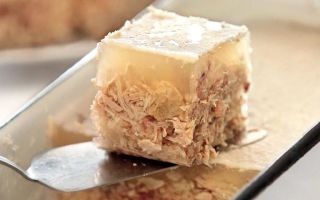Content
- 1 What is jellied meat and how did it appear
- 2 The chemical composition of aspic
- 3 How many calories are in jelly
- 4 Why is jelly useful for health
- 5 Aspic for the treatment of joints
- 6 The benefits of pork aspic
- 7 The benefits of beef jellied meat
- 8 Why is chicken jelly useful?
- 9 Is jellied meat useful for losing weight
- 10 Is jellied meat possible for pregnant and lactating women
- 11 At what age can jelly be given to children
- 12 How to cook jellied meat at home
- 13 Jellied meat harm and contraindications
- 14 Conclusion
- 15 Reviews
The benefits and harms of jellied meat are an urgent question for everyone who loves to feast on a gelatinous dish. It is interesting to understand what the product is made of, and what properties it has.
What is jellied meat and how did it appear
In fact, jellied meat is a transparent gelatinous jelly left after boiling a thick broth. The dish first appeared in the XIV century in France, where wealthy people could afford very rich meat soups. Initially, French chefs were skeptical about the taste of the jelly, but over time, a dish called galantine was invented. To create it, the processed meat was twisted to a jelly state, and then again sent to the broth and kept in the cold for some time.
Russian jellied meat appeared around the same time - although initially it was prepared from simple meat leftovers. The tradition of seasoning jelly with spices and spices arose later, and came from Europe.
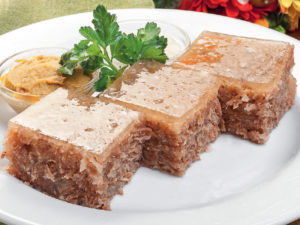
The chemical composition of aspic
Many people like the taste of jellied meat - but they value the product, first of all, for its useful properties. Namely, it contains:
- useful minerals - copper, potassium, phosphorus;
- elements fluorine, sulfur, rubidium;
- aluminum and boron, calcium and vanadium;
- polyunsaturated fatty acids;
- collagen and glycine;
- gelatin;
- retinol;
- valuable aliphatic amino acid;
- vitamins - C, B9, A.
Even a small portion of quality jelly brings great benefits to the body.
How many calories are in jelly
Since jellied meat is made from different types of meat, then the calorie content may vary.
- The most high-calorie is pork jelly - the calorie content is from 340 to 390 calories per 100 g of product.
- In second place is beef jelly - it contains 130 to 180 calories.
- The least high-calorie jelly is from lean poultry meat - turkey or chicken. It contains 80 to 200 calories.
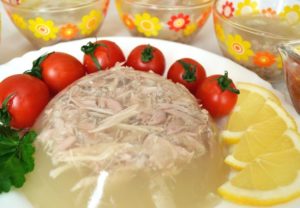
Pork jellied meat is recommended only for very healthy people - with many ailments, a fatty dish will be harmful. The most dietary properties are considered poultry and beef jellies.
Why is jelly useful for health
Meat jelly is not only nutritious, it tastes good and benefits the body. The specific valuable properties depend on what kind of meat the dish is prepared from. But there are also several common qualities inherent in any jelly. Namely, the product has a positive effect:
- on immunity - retinol, present in the dish, successfully fights viruses and infections;
- on joints - the gelatin in the product strengthens bone and connective tissues;
- on the nervous system - glycine in the jelly improves brain function and helps to get rid of depression;
- on metabolic processes - in particular, the properties of the product are very effective in the treatment of hangover syndrome.

Aspic for the treatment of joints
Among the useful properties of the product, one valuable quality is especially noted - a positive effect on joints and connective tissues.The fact is that any jelly, especially beef, contains a high percentage of animal protein. It is protein that is largely responsible for the rapid recovery of tendons, cartilage, ligaments and bones.
Regular consumption of beef or pork jelly is highly recommended for athletes. During training, their joints are subjected to particularly heavy loads and are often injured. Protein, collagen and carotene in the product will be able to protect bone tissue from destruction, and in addition, will further increase physical endurance.
The benefits of pork aspic
The beneficial properties of a pork shank, tail, ears or legs product are dictated by the valuable qualities of the pork itself. In particular, it contains amino acids and iron, vitamin B12 and myoglobin, animal fat.
Pork aspic:

- effectively protects the body from vitamin deficiency;
- replenishes calcium reserves;
- has a beneficial effect on the state of blood vessels and heart.
The benefits of beef jellied meat
Jelly made from beef is less fatty than pork and is much better absorbed, as much as 76%. Therefore, you can use the product even with many gastrointestinal diseases, it will not do any harm.
Beef jelly contains a large amount of vitamin A, therefore it is extremely beneficial for eye health. The product contains carotene, which strengthens muscle, bone and connective tissues, and contributes to their recovery. The benefits of beef leg jelly will be especially great for athletes whose muscles and joints are exposed to special stress.

Why is chicken jelly useful?
A product made from chicken or turkey meat, the most useful for those who dream of losing weight. The calorie content of the jelly is very low, and it contains a lot of valuable substances. These are the main vitamins C, A, B, elements: iron and magnesium, calcium.
Choline in chicken or turkey jellied meat helps to regulate metabolism and has a beneficial effect on the nervous system. Collagen present in the product is good for hair and skin. Also, therefore, the benefits of jellied chicken legs will be especially great for the fair sex.
Is jellied meat useful for losing weight
Jelly of beef or poultry meat, a medium-calorie dish containing a large supply of nutrients. Therefore, jellied meat on a diet is useful, but only in limited quantities. Of course, the product itself will not contribute to getting rid of excess weight, but on the other hand, it will maintain the balance of vitamins and trace elements in the body.
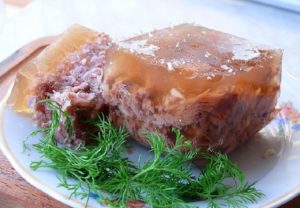
When using the product, during a diet, it is necessary to carefully calculate daily calories so as not to exceed the permitted rate.
Is jellied meat possible for pregnant and lactating women
During the period of carrying a child, jelly can bring both benefits and harm. The main danger lies in the fact that the product may increase blood cholesterol levels and gain excess weight.
However, the product also has benefits for pregnant women. Aspic improves the production of hemoglobin, helps to absorb calcium, removes toxins and strengthens the immune system. Therefore, it is still possible to take the product during pregnancy - just in small quantities, and after consulting a doctor.
Aspic with breastfeeding is also approved for use. It does not have a negative effect on the health of the baby. But you need to use the product without seasonings and herbs, in order to avoid allergies and colic in the baby.
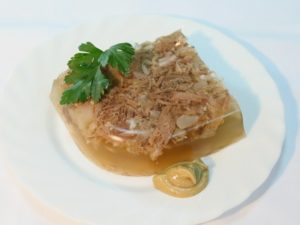
At what age can jelly be given to children
Classic jelly is too "heavy" food for the child's body. But the beneficial properties of the product are still important for growing babies. Therefore, children from 6 or 7 months of age are advised to offer a special homemade jelly for children - from chicken meat, without salt and other seasonings and spices.The benefit of chicken aspic will be that the product will strengthen the child's immunity and contribute to the development of bones and muscles.
Complementary foods should be started taking into account the amount of no more than a quarter of a teaspoon. If a negative reaction does not follow, then gradually, by the time the child is one year old, the amount of jelly can be brought to 50 g per day.
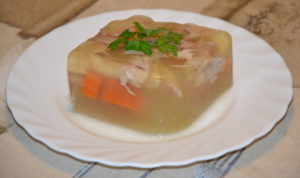
How to cook jellied meat at home
Classic jelly does not have to be purchased in the store - you can prepare the treat yourself at home. Since the benefits of beef jellied meat are the greatest, and the harm is minimal, then it is recommended to cook it. You will need to take the following products:
- peeled beef leg, or fetlock - 1.3 kg;
- beef of the highest category - 800 g;
- chicken breast - 1.8 kg;
- water - 3 l;
- carrots - 300 g;
- onions - 350 g;
- a little garlic - about 40 g;
- root parsley - 250 g.
It takes a long time to prepare the dish, but without any particular difficulties.
- Cut the beef leg and pour 2-3 liters of water, and then boil it for 8 hours over low heat, not forgetting to remove the foam.
- About 4 hours after the start of cooking, chicken and beef are added to the fetlock.
- After 7.5 hours, put the vegetables in the pan.
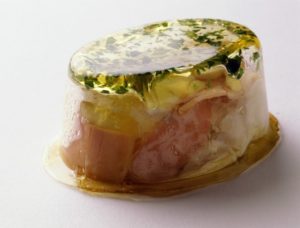
When the components of the future jelly are cooked, the meat is cooled to a warm temperature, chopped into small pieces or passed through a meat grinder, after removing all the veins and bones. The resulting minced meat is again put into the strained broth, salted, boiled for another 20 minutes, then garlic is added.
The finished jellied meat is distributed in forms and left for several hours in the refrigerator so that the jelly hardens properly.
Jellied meat harm and contraindications
No matter how high the benefits of the product, sometimes it can bring harm. The main risks are related to the fact that:
- fatty thick jellied meat contains quite a lot of cholesterol, so it can negatively affect blood vessels, liver and heart;
- the product contains growth hormone - it is harmful in large quantities or in the presence of allergies;
- pork jelly contains a substance called histamine, which is harmful to people with impaired bile production;
- jelly is high in calories and can contribute to weight gain when consumed without restriction.
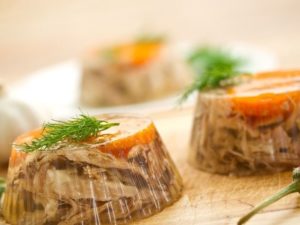
Thus, it is possible to highlight a list of diseases and conditions in which jellied meat is contraindicated. Namely, its properties will harm:
- with a tendency to obesity;
- in the presence of individual intolerance to any components;
- with diseases of the gallbladder;
- with gout;
- with severe vascular and heart ailments;
- in case of intestinal disorders - jellied meat, especially pork, is difficult to digest.
Nutritionists recommend eating the product no more than 2 times a week in small portions. Then the health benefits and harms of jellied meat will be balanced.
Conclusion
The benefits and harms of jellied meat depend on whether a person has strict contraindications to taking the product. If you do not get carried away with high-calorie jelly, then the health benefits will be unconditional.

Reviews

